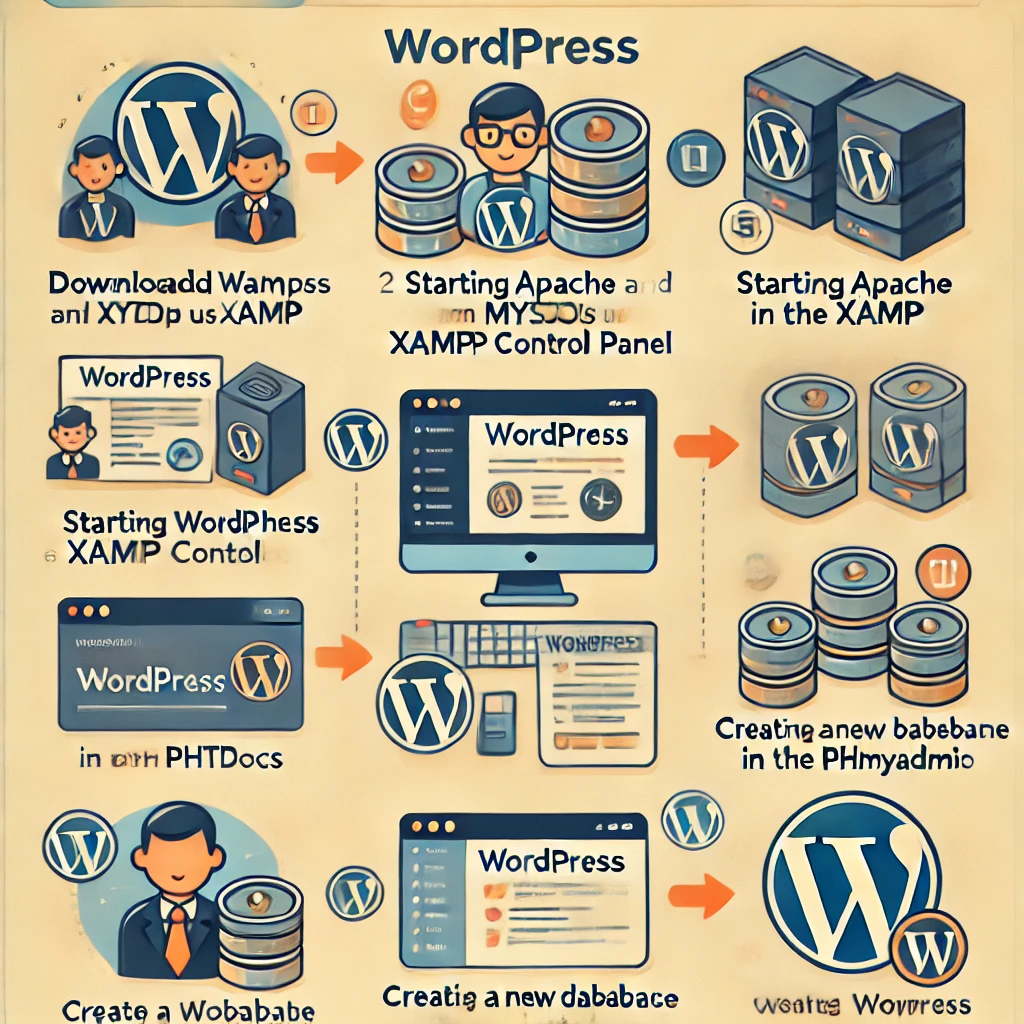Introduction
Installing WordPress on localhost is an excellent way to create and test websites locally before going live. Whether you’re a developer, blogger, or business owner, setting up WordPress on your computer helps you experiment and perfect your site without affecting your live environment. In this guide, we’ll walk you through a step-by-step process of installing WordPress on localhost using XAMPP.
What You Need Before Starting
- XAMPP software (a local server environment).
- WordPress installation package.
- A computer running Windows, macOS, or Linux.
Step 1: Download and Install XAMPP
- Go to the XAMPP official website: Visit https://www.apachefriends.org and download the XAMPP version suitable for your operating system (Windows, macOS, or Linux).
- Install XAMPP:
- Run the installer file you downloaded.
- Follow the installation wizard and select the default options.
- Complete the installation and launch XAMPP Control Panel.
- Start Apache and MySQL:
- Open the XAMPP Control Panel.
- Click Start next to Apache and MySQL to activate them.
- Verify Localhost is Running:
- Open a web browser and type
http://localhost. - You should see the XAMPP dashboard confirming everything is working.
- Open a web browser and type
Step 2: Download WordPress
- Visit the WordPress official website: Go to https://wordpress.org and download the latest WordPress version.
- Extract the WordPress Package:
- Unzip the downloaded ZIP file.
- You will get a folder named “wordpress.”
Step 3: Set Up WordPress Files in XAMPP
- Move WordPress Files:
- Copy the “wordpress” folder.
- Paste it into the htdocs folder within your XAMPP installation directory. Typically located at
C:\xampp\htdocs(Windows) or/Applications/XAMPP/htdocs(macOS).
- Rename the Folder (Optional):
- You can rename the “wordpress” folder to your desired project name (e.g., “mywebsite”).
Read More: Why Local SEO Matters for Small Businesses?
Step 4: Create a Database for WordPress
- Open phpMyAdmin:
- Go to
http://localhost/phpmyadminin your web browser.
- Go to
- Create a New Database:
- Click on “Databases” in the top menu.
- Enter a name for your database (e.g., “wordpress_db”).
- Select utf8_general_ci as the collation.
- Click Create.
Step 5: Configure WordPress
- Open WordPress Installation Page:
- In your browser, go to
http://localhost/wordpress(orhttp://localhost/your-folder-nameif you renamed it).
- In your browser, go to
- Select Language:
- Choose your preferred language and click Continue.
- Database Connection Details:
- Click “Let’s go!” to proceed with the setup.
- Enter the following database details:
- Database Name: The name of the database you created (e.g.,
wordpress_db). - Username:
root - Password: Leave it blank (default for XAMPP).
- Database Host:
localhost - Table Prefix:
wp_(you can change it if you want to improve security).
- Database Name: The name of the database you created (e.g.,
- Click Submit.
- Run the Installation:
- Click “Run the installation” to start the setup process.
- Site Details:
- Enter your site title, username, password, and email address.
- Click Install WordPress.
- Login to WordPress:
- After the installation is complete, go to
http://localhost/wordpress/wp-login.php. - Log in using the credentials you created.
- After the installation is complete, go to
Final Thoughts
Congratulations! You have successfully installed WordPress on localhost. You can now design, develop, and test your website locally without any risks. When you’re ready to go live, you can easily migrate your site to a live server.
FAQs
1. What is localhost?
- Localhost is a local server environment on your computer, allowing you to run websites without an internet connection.
2. Why use XAMPP for WordPress installation?
- XAMPP provides a complete local server setup with Apache, MySQL, and PHP, making it easy to run WordPress locally.
3. What is the default username and password for phpMyAdmin in XAMPP?
- The default username is
root, and the password is blank.
4. Can I install multiple WordPress sites on localhost?
- Yes, you can create multiple folders in the
htdocsdirectory and install separate WordPress instances for each.
5. How do I migrate my local WordPress site to a live server?
- Use a plugin like Duplicator or All-in-One WP Migration to export your local site and import it to your live server.







